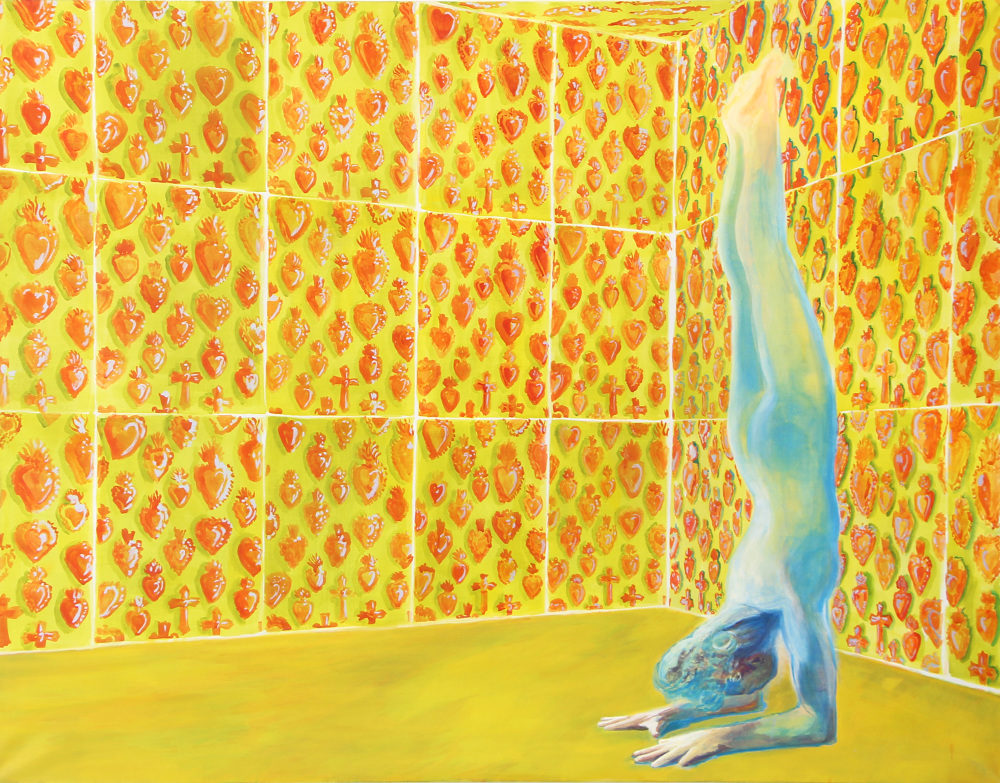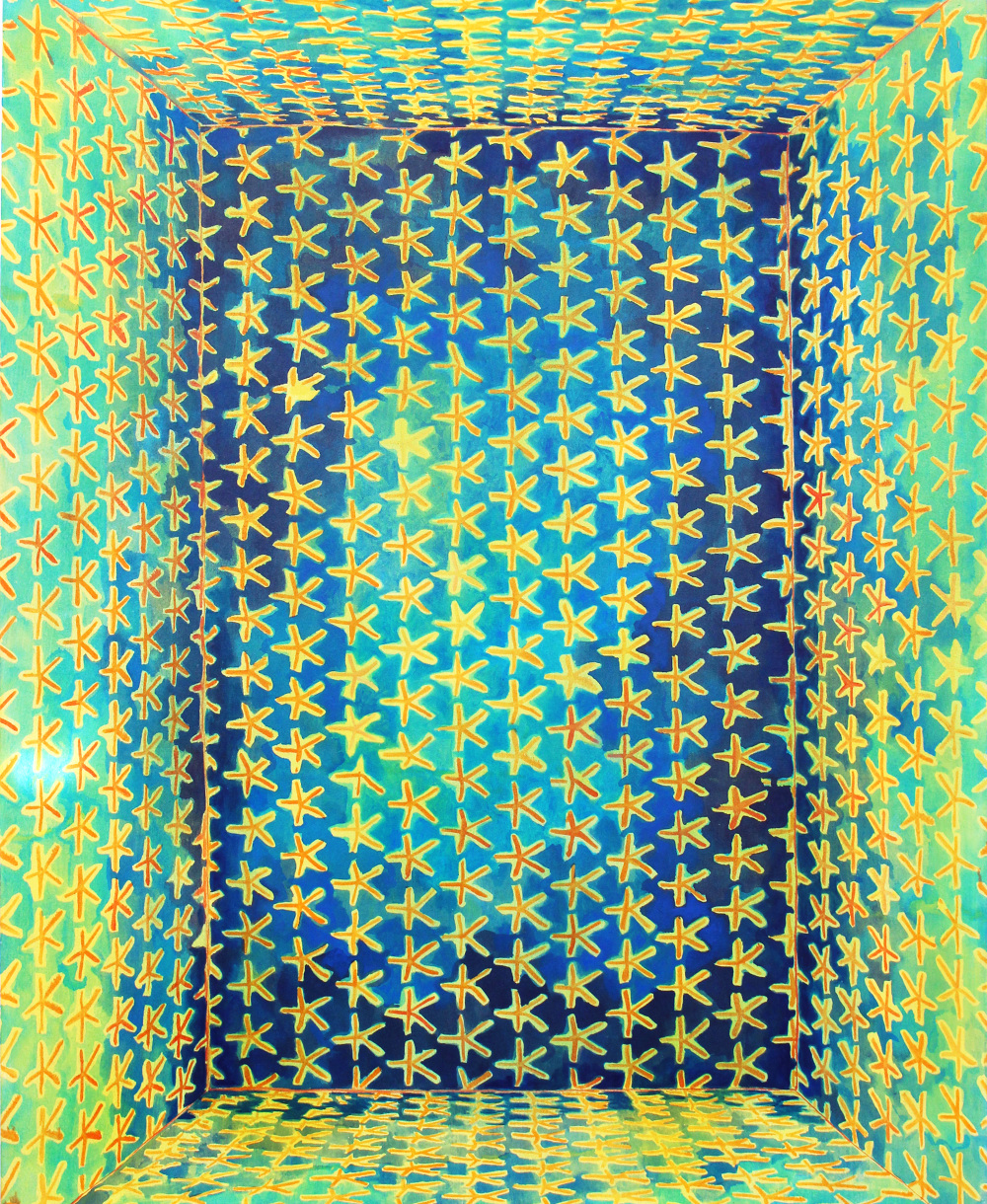Screening out – Cecilia Granara
Painting is a spiritual exercise. It is a canvas that we contemplate, colours that absorb us, another reality that opens up to us. In Cecilia Granara’s paintings, the exercise of the gaze is all the more profound as it joins a movement of meditation. The names of her series tell us, Women Doing Yoga, Meditation Series or Invisible Forces (2017) it is a reflection, an inner quest. We meditate to reach a level of peace, to enter into communion with the divine, the cosmos or even – and above all – to change our point of view. The characters she represents, as if immersed in themselves, act in this way as an invitation to take a break. The thinker is a smuggler.

Paradoxically, it is necessary to abstract oneself from everyday life, from its constraints and habits, to access the consciousness of being in the world. The characters we see evolve in spaces that have nothing ordinary. Tahitian women, for example, drowned in Gauguin’s motives, no longer seem to have their own identity. They are immersed in culturally constructed spaces that question them as individuals. The colours erase their lines, the hibiscus flowers cover their expressions: we only recognize the profile of the human being, a fragile line of demarcation. The extruded silhouettes give these women the thickness they lack, like 3D figures badly inlaid in the decor. Exoticism depersonalizes, and the choice to no longer put a hierarchy between figures and background here is the result of a post-colonial consciousness and a feminine perspective.
Cecilia Granara’s portraits are disturbing. The character encounters a pattern with which he blends and coexists at the risk of going unnoticed. It is not in the intention of making tapestries but, on the contrary, in the intention of returning the house. The interior of a person becomes that of a place and fills it all up. Mirrors encourage this vibration between an individual and his environment. They extend the body and clothing in a kaleidoscopic effect in Invisible Force 1 and blur perceptions of an agreed space. Are we the products of a community or the creators of the community in which we live? The issue is not settled. If the motifs reveal a character’s mental horizon – the votive decor of a church in Spain, Pierro della Francesca’s Italian frescoes in Women Doing Yogas refer to a religious and pictorial heritage – it seems possible to create one’s own universe through exercises and reflection, as suggested by the more recent painting Space in Your Head (2018).

Allegories of the modern world, these portraits in a cell show us individuals who seek to free themselves through bodily and spiritual action (yoga, meditation but also and more recently love). The floors, ceilings and walls surrounding them and featuring iconic motifs are as much reproducible as they are modular. The boundaries, which can be pushed back or integrated, seem to suggest the table and its four sides. The repetition of the starry sky motif in the Stars and Lovers series (2018) plays with perspectives and a symbolic dimension. The succession of shots between a couple kissing, a set and a drawing blurs the tracks. The subjects escape our attention both within and outside the framework. On their phones for some, they enter into a communication with the other, waiting for invisible text messages from another field. Present and at the same time absent, they screen their bodies at all our projections.
A certain amount of incommunicability is at play in these figures, which do not have a direct relationship with the spectator. The text that appears occasionally does not help in Meditation Series. Contradictions, “You’re alone” and “You’re not alone” work like mantras that, when repeated, build a temperament, either positive or negative. These slogans, which go together “Hold each others” and “Separate yourselves”, refer to the influence of the media on our lives. Our bodies are marked as much by the fictions of films, books and music as by our self-reports. Emily Dickinson’s texts thus resonate with certain watercolours and paintings and reinforce their symbolic aspect. The artist, after having assisted Francesco Clemente and travelled to India, now seeks to circulate these motifs from one culture and era to another.

The influence of the Indian miniature allowed him to purify his funds and reconnect with the sketch. The body is summed up in some paintings as lines of energy. The perception of oneself, which was the subject of many paintings, is enriched by the other’s gaze, the perception of oneself by the other with the introduction of the theme of love. Through one of her latest exhibitions Uncomfortable Love, Non-Sad Colours, Cecilia Granara takes up the love relationship and the notion of love to question monogamy and alternative models to the couple. She twists the projections to give us another screen. The paintings are reflexive, they question without any more hiding them the interplay of influence between a man or a woman and the collective imagination. In a painting entitled Triad (2017), a couple is kissed by a third character in the background whose hands are only visible. They envelop us until the gaze reaches a higher stage of consciousness.






